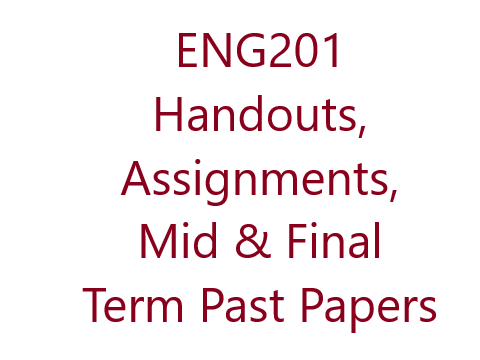ENG201 Handouts, Assignments, Mid & Final Term Past Papers are discussed below. This course focuses on increasing students’ writing and oral communication talents so they may communicate more effectively in a variety of corporate settings. The course has been designed with the following goals in mind: to identify and address the needs for effective communication by developing communicative skills among learners; to sharpen learners’ abilities to communicate in a persuasive, clear, and concise manner; to plan and organize effective written messages and present them in an appropriate form.
To improve students’ understanding of different types of writing; and to equip learners with the fundamentals of business and technical English writing. An oral report can be given to a small group of people around a table or a big audience in a vast auditorium. Formal oral reports are typically well-rehearsed because they are prepared in advance of the presentation. In an official oral report setting, your delivery style is crucial.

ENG201 Handouts, Assignments, Mid & Final Term Past Papers
Formal oral reports may be delivered in a setting like a big auditorium or hall to an audience of one’s peers or to an interested general or mixed audience, and they may follow an outline similar to the sections of any formal written report. Informal oral reports are typically given in small groups with lots of audience participation, a casual delivery style, and casual attire. Informal oral presentations have the potential to encourage the open flow of ideas and are useful for generating action items.
Introduce yourself and greet the audience (for instance, “Good morning, ladies and gentlemen”). The recipe for effective presentations is to inform the audience of what you will say and then summarize your points. Respect the time limit. Do your best to keep it brief. Underrunning is preferable to overrunning. As a general rule, allot two minutes for each overhead transparency or PowerPoint slide you use, but more time if you wish to elaborate on any of them. In general, 35mm slides are used less frequently and are displayed for longer.
However, if you show something on the screen for more than five minutes, the viewers will become bored, especially if you are not actively discussing it. Therefore, turn off the display or substitute a slide with some kind of “wallpaper,” like a company emblem. Avoid veering off course throughout the presentation; doing so will take up time and put you in a bind from which there is no way out.
Lesson Learning Objectives
You would be able to after the course to:
- spoken communication example
- examining the audience
- The seven C’s of Communication should be used when writing communications
- Plan business memos, reports, proposals, reports, and evaluative analyses.
- put visual aids to use in presentations
- understand how to avoid typical writing issues
- use the punctuation characteristics
- connect with genuine materials to understand and put business concepts into practice
- Communicate concisely and clearly in a variety of business settings.
Unless specifically instructed otherwise, give time for discussion. For point clarification, five minutes will do. If the questions start to get intriguing, the session moderator may extend this. Ask if there are any questions after you finish your presentation. To avoid being abruptThe audience may find it daunting when you do this since it could be perceived as any questions. If so, it’s an indication that you weren’t paying attention. Have a question prepared so that you can start the conversation if the questions are slow to come.
Talk loudly. Avoid shouting or whispering. Analyze the room’s acoustics. Avoid rushing or speaking slowly on purpose. Be genuine, but avoid being talkative. Pause on purpose at crucial occasions to highlight the significance of the message you’re trying to make. Avoid making jokes; they are almost always bad unless you are a natural. Use your hands to emphasize ideas, but avoid excessive hand motions. Inquire occasionally about your style from coworkers.
As much as you can, look out at the crowd; avoid focusing on any one person because it can be threatening. Particularly in bigger venues, lean your presentation towards the rear of the crowd. Never speak to the screen on the wall behind you while facing it. Make sure you are familiar with how to use the equipment and when you need specific displays to appear when they’ll do so, and the signals you’ll employ. Edit your slides as carefully as your talk; remove any unnecessary slides. Duplicate a slide if you need to utilize it more than once. Slides and OHPs should only provide the information that is absolutely necessary.
Otherwise, there is a risk of making the slide difficult to understand or will draw your audience’s attention in another direction so they spend time reading the slide instead of paying attention to you. Ten words at most on each slide are the ideal number to aim for. Use a typeface that will enlarge well and decent font size. Times New Roman should typically be at least 18 points on OHPs, preferably larger. A general rule is that the OHP is usually “OK” if you can read it without projection at a distance of two meters.
In your discussion, avoid utilizing a diagram that was created for a technical report. It will be very complex and challenging to read. Use color on your slides, but stay away from orange and yellow because they project poorly. White or yellow on blue is a pleasing visual combination that makes the text easy to read. The design of slides is frequently covered in great length in books on presentation skills.
ENG201 Handouts:
There are handouts on the linked page “ENG201 Handouts“.
ENG201 Past Papers:
ENG201 Midterm Past Papers:
ENG201 Midterm Past Papers will be available soon.
ENG201 Final Term Past Papers:
ENG201 Final Term Past Papers will be available soon.
ENG201 Assignments:
ENG201 Assignments will be available soon.